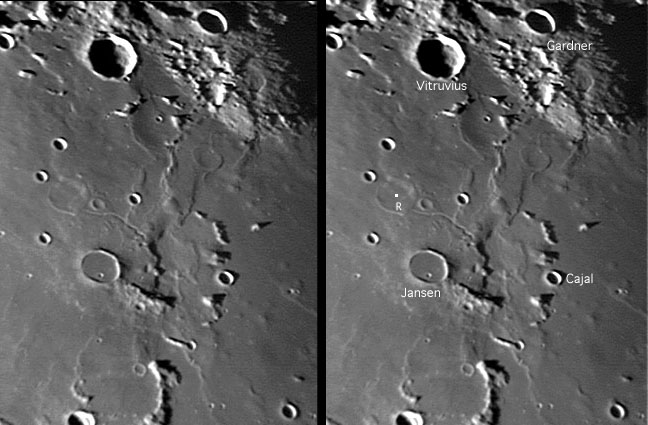November 24, 2015
Ghostly Terrain
Originally published December 5, 2004
Image Credit: KC Pau |
|
Ghostly Terrain A broad line of ridges and half buried craters that I call the Lamont-Gardner Megadome Alignment (LGMA) is one of the Moon's unexplained mysteries. There are other ridges of ghostly craters, but this structure in northern Mare Tranquillitatis is perhaps the most bizarre. KC's picture shows that it is an alignment of ruined and ghost craters (Jansen R is one of the few with a designation) that leads directly to the largest dome on the Moon - the Gardner Megadome. Jansen has a darker floor with fewer superposed impact craters than the surrounding mare - therefore the floor of Jansen is younger and probably of different composition. The floor is 340 m below Jansen's rim crest, and the rim rises on average 600 m above the adjacent mare. Thus, like Wargentin, the floor of Jansen is higher (260 m higher) than its surroundings. The west side of the rim is breeched - it would be interesting to see a high res, low sun view to check if there is evidence that lava flowed out of the crater onto the mare. The Jansen Rille starts at a Cobra-Head like collapse feature and flows 75 km, ending at a ghost crater. According to the LTO, the source vent is about 280 m higher than the end of the rille, proving that it did flow downhill. The young lava in Jansen, the source of the rille, and a rimless collapse pit east of Jansen all point to this segment of the LGMA being more than simply a buried ridge - it has been the source of lavas. This supports the idea that the aligned Gardner Megadome really is a volcanic structure and perhaps its summit arc is a caldera. Adding speculation on top of speculation, if the northern end of the LGMA is volcanic, is it possible that so is Lamont at the southern end? Technical Details: Related Links: Yesterday's LPOD: Telemann Flows Tomorrow's LPOD: Seeing Red, and Blue and Yellow |
|
Author & Editor: |
COMMENTS?
Register, Log in, and join in the comments.




